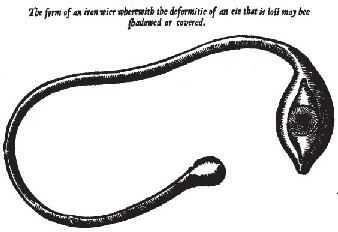
Eye Wounds and Surgery Page Menu: 1 2 3 4 5 Next>>
Eye Wounds and Surgery During the Golden Age of Piracy, Page 4
Wounded Eye Surgery - Cauterization
Although cauterization (the burning of a wound to stop flows of viscous material from it) was falling out of favor at this time, some surgeons still used it. It was primarily used on or around the eyes
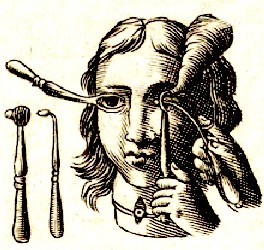
Cauterization of the Eye, from Johannes Scultetus'
Armementarium Chiurgicum, p. 111 (1665)
mostly when there was an ulcer or inflammation of the surrounding skin or eyelids that was weeping fluids that the surgeon couldn't otherwise stop.
Of our sea surgeons, only one has anything to say about cauterizing the area around the eye. It should be noted that cauterization would not often be used shipboard for a couple of reasons. First, it is a delicate operation, especially in relation to the eye, and an ever-moving ship is not the best place for such things. Second, fires on a ship were doused when it was in battle or underway due to the risk of spilled coals setting the wooden ship alight.
Nevertheless, Atkins presents the case in his book designed to be read by young sea surgeons, so he clearly felt there could be an opportunity for them to use it. As he explains it, the cautery should be applied at the place near "the Complaint: In Distempers of the Head or Eyes, they are put on the Forehead; Temples, behind the Ears or Neck"1. Lorenz Heister gives a more detailed explanation, showing how a cautery could be used in the corners of the eye as shown in the image above, but this would most likely not be done shipboard for the reasons mentioned previously.
1 John Atkins, The Navy Surgeon, p. 182-3
Wounded Eye Surgery - Couching
Couching is an operation for fixing cataracts. A cataract is caused by clouding in the crystalline lens of the eye,
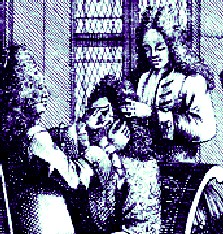
Couching from A General System of
Surgery by Lorenz Heister (1750)
which dims the vision. Couching involves holding the eye open and sticking a needle into it to either push the cataract out of the way or break it apart. It has a long pedigree; the ancient Roman surgeon Celsus gives a detailed description of the procedure in his book De Medicinae in the first century AD.1
However, I have found no mention of this operation in any of the sea surgeon manuals, which is why I believe it would not be performed by most sea surgeons. Still, it was one of the most intricate and widely discussed surgical procedures for the eye and several renowned land-based surgeons such as Lorenz Heister and Pierre Dionis give detailed procedures for its performance.2 In fact, most of the drawings you see in this article of surgeons and their assistants standing over a seated patient are actually to explain the couching procedure. So couching gets an honorable mention on this page for its importance to the field. Because it is doubtful that any pirate surgeon during the golden age of piracy ever performed it we'll leave the details for those who want to read the footnotes and enjoy the research process.
1 Cornelius Celsus, Of Medicine, Translated by James Grieve, 1756, p. 402-5; 2 See Pierre Dionis, A course of chirurgical operations: demonstrated in the royal garden at Paris. 2nd ed., p. 302-6 & Lorenz Heister, A General System of Surgery in Three Parts, p. 402-8
Wounded Eye Surgery - The Eye Speculum
An eye speculum is a device used to keep the eye open during surgery. (I can tell you from personal experience that they are still in use today, although the technology has improved a bit.) Most of the surgical authors who give images of surgical eye tools include a speculum, but few of them talk about its use in the operations I include. One images I include in this article show an assistant keeping the patient's eye open during eye procedures (as seen below left.) Yet, right there, standing as tall as the figures in the picture, is the eye speculum.
In one of his rare illustrations of eye instruments, Ambroise Paré shows us a speculum (below center left), explaining that it is the "delineation of a Speculumn oculi, fit to dilate and hold asunder the eye-lids, and keep the eye steddy, it is so made, that it may be dilated and contracted according to the greatness of the eyes."1 His contemporary, Jacques Guillemeau accompanies his illustration (seen below right) with even more detail. explaining that the device is a "Dilatorye of the Eyeliddes, or the Speculu[m] of the Eye, whe[n] we endevoure to take anye alienate thinge therout".2 He also explains the loop, telling the reader "On this place the miroure of the Eye openeth it selfe, accordinge to the magnitude of the Eye."3
So it was clearly used, even if it isn't explicitly mentioned in some of the procedures.
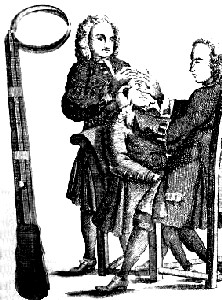 From A General System of Surgery by Lorenz Heister (1750) |
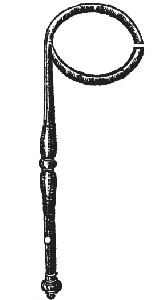 From Workes of that Famous Chirurgeon Ambroise Parey |
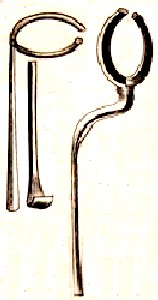 From Cornelius Solingen, Alle de Medicinale (1698) |
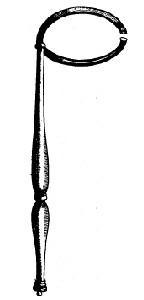 From French Chirurgerye, Guillemeau, p. 25 (1612) |
1 Ambroise Paré, The Workes of That Famous Chirurgeon Ambroise Parey, p. 596; 2 Jacques Guillemeau, The French Chirurgerie, p.24; 2 Guillemeau, Ibid.,
Wounded Eye Surgery - Post Surgery Eye Movement Prevention
Several of the period surgeons recommend preventing eye movement following surgery. For, as Paré
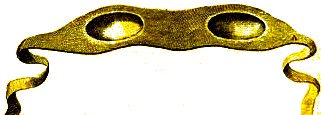
A General System of
Surgery by Lorenz Heister (1750)
explains, "one eye cannot be moved without some motion of the other by reason of the connexion they have... when the one suffers, the other in some sort partakes therewith."1 So he
recommends that "in diseases of the eyes, the Patient lye with his head somewhat high, and that
he keep shut not only the pained, but also the sound eye, because rest is alwayes necessary for the grieved part."2
James Handley concurs, explaining that "when one Eye is wounded, we roll up both."3 He goes on to explain that both are rolled because "Light, at such a time, is prejudicial to the Eye; and if only one Eye be rolled up, and the other exposed, that which is exposed moves, and by its Motion causes the wounded Eye to move also; which retards the Cure."4
1 Ambroise Paré, The Workes of That Famous Chirurgeon Ambroise Parey, p. 292; 2 Ibid.; 3 Ibid.; 4 James Handley, Colloquia Chirurgica, p. 117; 4 Ibid.
Lost Eyes - Treatment
We finally come to the problem that would cause pirates to need eye patches - the loss of an eye.
Ambroise Paré explains that if "through anie mischance, as by anie inflammation, anie man's eie happen to bee broken or put out, and the humors split or wasted; or if it bee stricken out of his place or cavitie wherein it was naturally placed by anie violent stroke; or if it waste or consume by reason of a consumption of the proper substance, then there is no hope to restore the sight or function of the eie".1
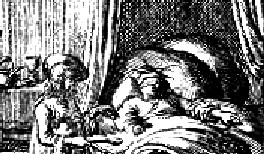
A Surgeon and His Patient from A Physical
Dictionary
by
Steven Blankaart (1685)
Basically he's telling us that there wasn't anything a surgeon could do for a lost eye at this time. The only sea surgeon to even address the problem was James Handley, who was with the British Royal Navy. Handley explains that, except in the case of children, when all the 'Aqueous Humor' (as he calls it) or the 'Crystalline and Vitreous Humors' come out, "the Sight is of necessity lost."2
His only recommendation for this is to dress the eye with a medicine. Rx. "Lap. Tutiæ [Tutty (zinc oxide), an astringen], & Calaminar. Præparat. [powdered calamine or zinc oxide] Ter. Sigillat. [Terra sigillata - reddish-brown clay used as a general cure] Sang. Dracon. [Sanguis Draconis or dragon’s Blood - a bright red resin used to wash wounds, promote healing and stop bleeding] Sarcocol. [Sarcocolla - gum resin thought to cause healing in wounds] &c. very finely searced [sifted]."3
1 Ambroise Paré, The Workes of That Famous Chirurgeon Ambroise Parey, p. 576; 2 James Handley, Colloquia Chirurgica, p. 118; 3 Handley, p. 119
Lost Eyes - Of Patches and Replacements
At last, we get to the eye patch!
Well, actually no, we really don't.
In all of the period and period-published surgical manuals I have read to date, I have only found one reference to an eye patch, and that reference is quite a bit different from what springs to most people's minds when you start talking about pirate eye patches. However, two surgical authors do talk about replacing and covering lost eyes, so let's take a closer look at what they have to say.
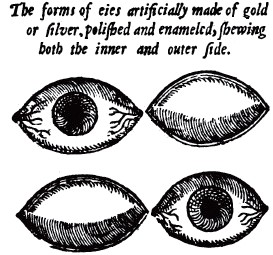
Artificial Eyes, from Paré's book The Workes of that
Famous Chirurgeon Ambroise Parey, p. 597
Ambroise Paré has a whole section of his book devoted to prosthetics and he explains that "you may cover the deformitie of the eie so lost (which is all you can do in such a case) by this means: If that when you have perfectly cured and healed the ulcer, you may put another eie artificially made of gold or silver, counterfeited and enameled, so that it may seem to have the brightness, or gemmi decencie of the natureal eie, into the place of the eie that is so lost."1
Paré's contemporary and son-in-law, Jacques Guillemeau, give us another rendering of an artificial eye (seen below left.) His description is of an "artificialle Eye of Gould, which is engravene, & under[neath] hollowe."2
Pierre Dionis agrees with Paré, recommending a replica "be made of Crystal... of the same Figure with the remaining Eye, and also a little larger, they being to be fix'd betwixt the Eye-lid to hold them. They are to be painted of the same Colour with the natural one, and bak'd in a Furnace, as is the painted Glass in Church-Windows."3
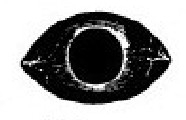
Artificial Eye from Jacques
Guillemeau's The French
Chirurgerie,
p 152 (1612)
This actually sounds like a cheaper and more accurate option than the enamelled gold or silver eye suggested by Paré. Dionis says as much, suggesting that "[w]hen an Artificial Eye is well fixed, it looks like the other, except that it cannot move it self, unless only when the Body of the blind Eye is not very much wasted and shrunk; for then we discern some Motion which depends on that of the Ball of the Eye on which 'tis placed."4 However, he also cautions that the wearer is "obliged to have several in reserve, because they may fall or break."5
As a replacement for a seaman (and more particularly a pirate), an artificial eye would probably have been an unobtainable luxury, however. It would have been expensive and would have to be custom-fitted to the wearer. Expense would have meant most seamen would be unable to obtain one and custom fitting would have made it difficult for a pirate to get. (Unless he could find a way to pose as a regular citizen; most pirates would avoid ports that would have been big and respectable enough to support a maker of such an item for fear of being recognized and caught by the local gendarme.) In fact, I have come across no accounts yet that tell of pirates with artificial eyes.
This leaves the cheaper and easier to obtain alternative - patches. Paré gives us some insight into this as well.
But if the patient bee unwilling, or by reason of som other means cannot wear this eie so prepared, in his
An Eye Covering from Paré's book The Workes of that
Famous Chirurgeon Ambroise Parey, p. 596 head; you may make another on this wise. You must have a string or wier of iron bowed or crooked, like unto women's ear-wiers [earrings], made so to bind the head harder or looser, as it pleaseth the patient, from the lower part of the head behinde above the ear, unto the greater corner of the eie; this rod or wier must bee covered with silk; and it must also bee somewhat broad at both ends, lest that the sharpness thereof should pierce or prick anie part that it commeth unto. But that end wherewith the emptie hollowness must be covered, ought to bee broader then the other, and covered with a thin piece of leather, that thereon the colors of the eie that is lost may bee shadowed or counterfeited. Here followeth the figure or portraiture of such a string or wier.6
You may again be struck by how elaborate Paré makes his eye "patch" - silk-covered iron wire and a leather eye covering with the figure of an eye painted upon it. It is doubtful that a surgeon at sea would go to this much trouble if an eye patch were needed. He would most likely talk with the sail-makers and have them make him one out of a piece of twine sewed to a bit of canvas. Please note that this is pure speculation on my part based on what seems to me to be the most logical sequence of events. Just as I have not found any evidence of pirates with false eyes, I have not come across any period accounts of eye patches being made for pirates. In fact, I have come across no descriptions of eye patches on pirates or sailors from the period. But that is a subject big enough for a new page.
1 Ambroise Paré, The Workes of That Famous Chirurgeon Ambroise Parey, p.576; 2Jacques Guillemeau, The French Chirurgerie, p.24; 3 Pierre Dionis, A course of chirurgical operations: demonstrated in the royal garden at Paris. 2nd ed., p. 312; 4 Ibid.; 5 Ibid.; 6 Paré, p. 576

